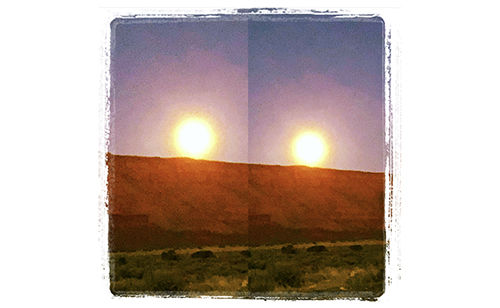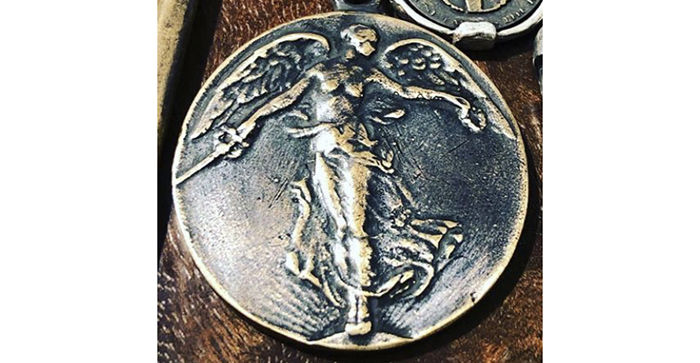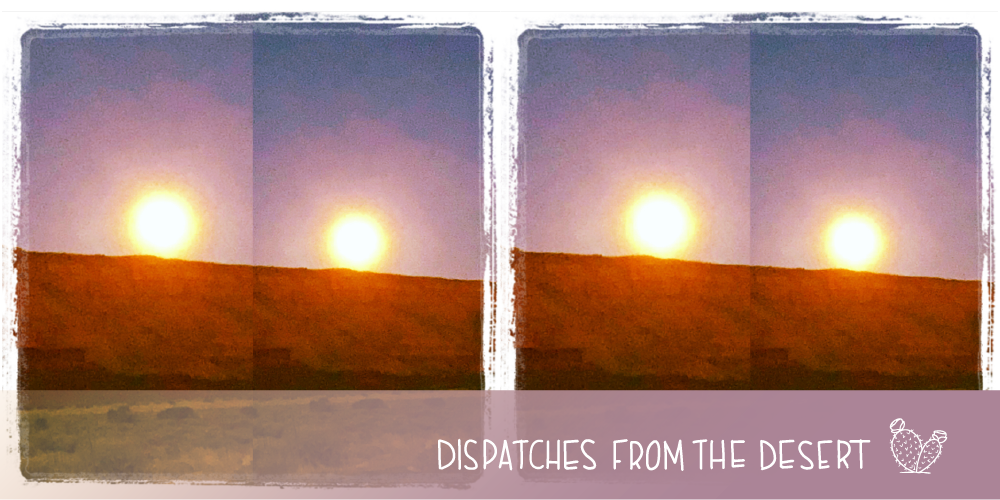9 April 2020
Castle Valley, Utah
his morning I feel afraid. It is unusually still. Brooke is not here. My brother Hank who is living with us during the pandemic, is not here. And out of the three dogs inhabiting our household, only one remains. Winslow Homer, our rescue chihuahua lays by my side. Not even the meadowlarks are singing. All I hear is a ringing silence.
Perhaps it was the power of last night’s “Pink Full Moon.” We watched it rise above Adobe Mesa. Live Science reports, “The pink moon is also a supermoon. It is about 0.1% closer to Earth than the March full moon was, making it the most super of the supermoons for 2020, NASA reported. Moreover, this pink supermoon will appear 7% larger than an average full moon.”
From our porch, this supermoon appeared as an immense spotlight in the desert casting a blue lens across the valley where everything seemed visible, even the shadowed silhouettes of owls.

I feel afraid. The moon wasn’t pink as promised, an homage to pink phlox that cling close to the ground each spring with a pop of fuschia. Pink in the desert is expressed through clouds holding the last light of day or the early blossoms of penstemon or the sticky geranium not expected until summer in the high alpine meadows in the LaSals. Pink in the desert is more likely to appear on white skin unprotected from the sun or the color of sand on the banks of the Colorado River. Pink is the rose quartz that rests on my bed stand said to nurture unconditional love, to support compassion and peace, carrying the energy of tenderness and comfort. It is also said to reduce lung problems and strengthen and balance the physical heart, as well as the metaphorical one. I do not see the metaphysical properties of minerals as soft thinking, I see it as Earth’s innate properties of healing, essential to our wellbeing.
Pink is emergent as in emergency.
Code Pink in a hospital is an alert of an infant child abduction.
Code Pink in politics is a woman-led movement supporting peace and human rights, working to end U.S. wars and militarization through non-violent actions.
And what about this phrase, “in the pink?” The Grammarist tells us, “In the pink is an English idiom that means to be at the peak of health, to be in perfect condition. The expression in the pink goes back to the 1500s when the word pink did not refer to a color. At that time, the word pink referred to a certain type of flower called dianthus…”
We are not in the pink.
I am afraid. I am afraid because I am a person who takes signs seriously. I’ve been home from Cambridge, Massachusetts for a month now. Since being in Utah, I have been wearing a necklace with a winged warrior wielding a sword. It felt like protection. This morning the necklace fell off. And when I walked into the kitchen, I dropped my cup of tea watching it shatter in a display of [pointed] JAGGED shards. I cut my hand trying to pick up the SHARP glass splinters. I am waiting for the third thing. Though these are small acts, they speak to me. There is no protection, only cautionary practices. Wash hands. Keep your distance. Cover your mouth.

Life in Castle Valley during the pandemic has seemed routine in beauty and rhythm, except for this ongoing low-lying fever that hangs over all of us with the knowledge that the novel coronavirus is here. Our internal and external antennae of what a million and a half cases of COVID-19 means due to this global pandemic makes us uneasy and vulnerable. Immunity from these symptoms, physical and psychological, is couched in denial.
Castle Valley is remote. But we are not immune. Today’s headline in the New York Times reads: Coronavirus Was Slow to Spread to Rural America. Not Anymore. The article states, “More than two-thirds of rural counties have confirmed at least one case.” This is now true of the county where we live.
I am afraid. I am afraid for Brooke, my brother and father, his wife, our families and friends. I am afraid for the doctors and nurses and grocery clerks and warehouse workers like our son and all who do not have the luxury of staying home. I am afraid for our elders and all we stand to lose without their wisdom. I am afraid for the children and who they will never know.
And if I am honest, I am afraid of getting sick as we watch people we know and love die – even in the name of casting one vote. I am afraid for the health of our democracy.
But what really scares me is that when this is over and it will be over — we just don’t know when — I am afraid I will go back to my life as it once was, reckless and extravagant, unconscious and in motion, overscheduled and overwhelmed, never allowing myself to pause and sit quietly – alone and with others — where to feel together the unease of living in an uncertain world becomes a spiritual and ecological imperative to change.
The Earth is speaking. Will we listen? This is what frightens me the most.
Last night’s Pink Full Moon had a corona around it – a garland, a wreath, a crown — and it was rose-colored. I did not have my glasses. I did not see one moon, I saw two.
Call it double vision. When my brother told me he thought he may have the virus, I expressed my deep concerns. He is among the vulnerable. He texted me, “Ter, whatever is going to happen, already has – I will not live in fear.”
Terry Tempest Williams
For many, the effects of COVID-19 are proving to be unprecedented—from losing a sense of certainty and security to losing loved ones. Harvard Graduate School of Education student Niharika Sanyal reflects on the uncertainty of death, taking a moment to sit with the loss and grief of this difficult time.
Terry Tempest Williams is a writer, naturalist, activist, educator—and patient. In this sixth “Dispatch from the Desert,” Terry reflects on triage, triangles, and how service brings purpose to our lives.
Even before the Covid-19 pandemic, grief was and is a normal part of the workplace, especially when you work in health care. As a leader, it’s often hard to know what to do. The Resiliency Center’s Megan Whitlock draws from the wisdom of colleagues to share four practical ways to manage grief in the workplace.
